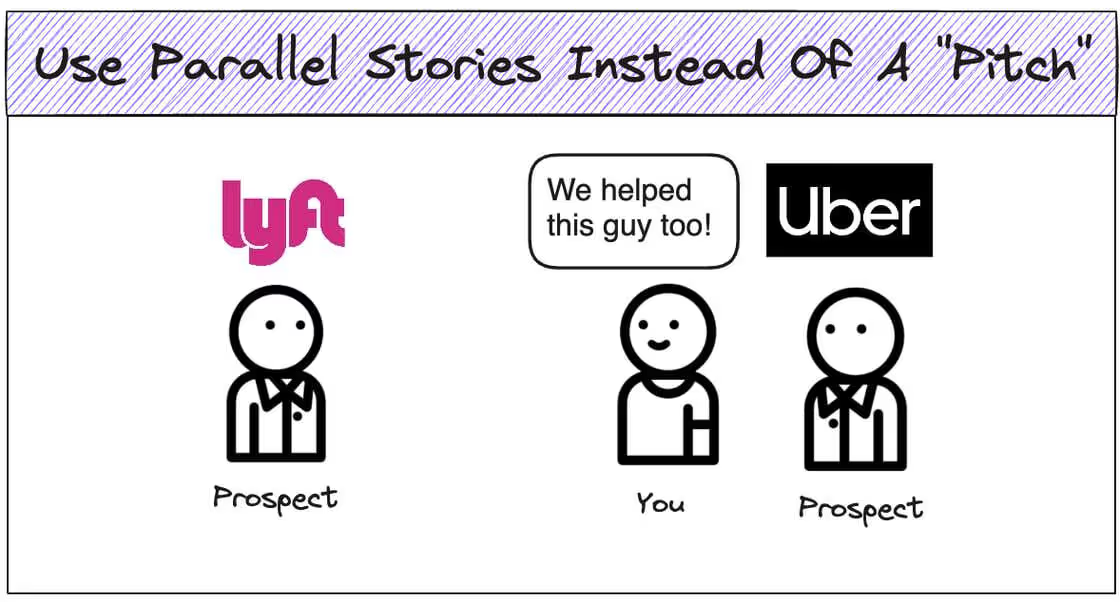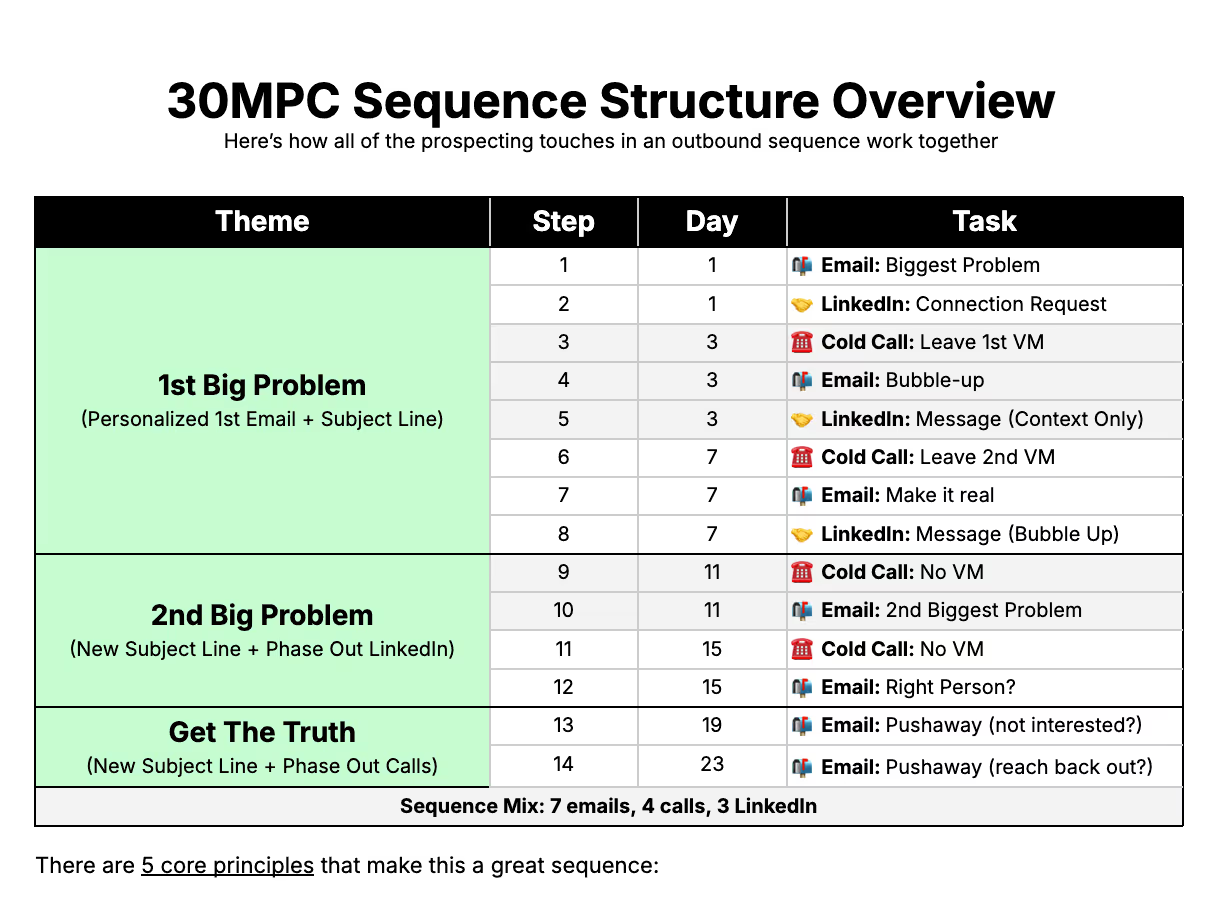Learning discovery is the single hardest part of sales.
That first sales call can go one of a million different directions.
You see the lists of "47 discovery questions" and you try to memorize them all.
Your sales manager is pinging you on Slack when your prospect mentions a competitor.
I get it. It's hard.
But the last thing you want to do it overcomplicate it.
If you break the discovery call into the sum of its parts, you can rely on a general structure as a guide for your call.
Control the beginning, control the end, find 1-2 big problems... then you can layer on all the fancy tricks from there.
This is my 4-Step Minimum Viable Discovery Call Framework that I'd use as a starting point when teaching people to close in my time as a VP of Sales.
- Use PPO to Set an Agenda
- Use Situation-Problem-Impact to Find a Problem
- Use Stories to Make It a Conversation
- Use the 5-Minute Drill to Drive Next Steps
Let's roll.
Step 1: Use PPO to Set an Agenda

Just as we’re getting into our discovery call flow, how many times have we had a prospect abruptly interrupt with a “Can I just see a demo?” or “I really just need to know pricing!”
When you set a proper agenda, the prospect knows exactly what to expect and has the opportunity to opt-in to the conversation.
Doug Landis taught me a simple agenda that I use in every single step of the sales cycle: Purpose, Plan, and Outcome.
Purpose - Set the expectation upfront that this call will not be a product dump, but rather an opportunity to see if there is a problem that our solution can solve for:
“Before we dive in, here’s the agenda for today. The goal of this call is to get a sense of your priorities around brand awareness and demand gen and see if 30 Minutes to President’s Club can support them or not."
Plan – Walk through how you plan to run the call to achieve that purpose, and set the expectation that you need to understand their business so you know what to show them on the demo that would be most relevant:
“So I’d love to gain more clarity on how you’re approaching those things today and share a bit about where we can help, even if that means we do a 5-minute overview of how it all works toward the end of the call.”
Outcome – Be clear on the goal attached to this call so that the prospect knows exactly what you are driving towards with your questions, and the decision that they will be faced with at the end:
“And by the end, I’d love to have a frank discussion around whether or not you felt we could be a fit. Is there anything else you wanted to get out of this one?”
Got your opt-in? Let’s dive into the good stuff.
Use Situation-Problem-Impact to Find a Problem
.avif)
Too many discovery calls stay at the level of process/situational questions that sound like "how do you do this?" or "walk me through your process for this."
Situational and process questions lead to discovery fatigue because they feel like doctor's checklist questions. They lead to surface level discussions that rarely unveil a problem.
Instead, you want to find their situation quickly, turn that situation into a problem, then figure out why that problem impacts the business.
Here's my favorite question framework to do that, from my time selling compensation software at Pave:
1) Ask why they took the call to figure out their situation:
“My guess is you don't take every sales call that comes your way. I guess, what prompted you to take this one in the first place?”
(Oftentimes they'd complain that they're running compensation reviews on spreadsheets, which isn't really a problem yet... so let's turn it into one!)
2) Use typically questions to find a problem:
“Typically when someone's tired of running compensation on spreadsheets, it's because it's taking so much time <or> it's because they can't oversee manager decisions across a million compensation workbooks. Which is it for you?”
(They often would say... both! But let's pick the tougher one -- it's taking so much time. Time savings doesn't sell a 6-figure deal. So I have to turn it into real business impact.)
3) Use magic moment questions to get an impact story
“I have to imagine you didn't wake up yesterday and think 'these spreadsheets have to go today!' -- I guess, when'd you realize that this was a problem?”
(And at this point they'll usually go on a long rant about how they spent 17 hours doing compensation reviews and accidentally made a mistake on one of their 3000 spreadsheets or lost 2 HR employees in the making of this merit cycle).
We got their situation. We got a problem. And we know that problem hurts.
But AS we're asking these questions... we have to give as we go.
Use Stories to Make It a Conversation

"WHY ARE YOU ASKING ME SO MANY QUESTIONS!?"
You hear this for one of two reasons: either you asked too many situational questions or you asked 3000 questions in a row.
My rule of thumb is to tell a short "Parallel Story" whenever they share a problem.
The most powerful way to "pitch" is to tell a story of how a lookalike customer solved this problem with you. Not by making claims about your product yourself.
For example, if I heard they were pulling all-nighters during their comp review, I'd say:
“Yeah, it's brutal. I was talking to another customer who just raised their Series C, and they don't have a fully-built compensation team yet either. But they have hundreds of employees and all the work falls on the 2 people ops folks.”
This allows you to pattern match and demonstrate industry expertise, while leaning on your customers to do the selling for you.
Use the 5-Minute Drill to Drive Next Steps
.avif)
Believe it or not, not every deal deserves a next step.
That’s where The Five Minute Drill comes into play. You want to validate that they have intent to buy... at some point soon... and THEN set the next step.
Ask these 3 questions at the end of every discovery call to run The Five Minute Drill:
Question 1: Do you wanna buy?
You want to confirm that this is leading somewhere and that your time won’t be wasted. Honestly, I usually just ask:
"So... what do you think?"
But if they suggest next steps or give you a wishy-washy answer, pressure test them:
“Before we talk next steps, I know this evaluation will require both of us to invest a good amount of time together -- pulling teams together for a demo, partnering together to build a business case, etc. -- so knowing what you know today, is it worth continuing to invest more time together based on what you've seen so far?”
Yes? On to question #2!
Question 2: When do you wanna buy?
You can’t suggest next steps that make sense if you don’t understand their timeline for solving the problem. Use what you know to seed the timeline, and then make the ask:
“Great, you mentioned that merit cycle was happening in Q3. I know we’re still early, but assuming all goes well in our next few conversations, when’s the latest you’d want something like this in place?”
Reasonable intent to buy within the next 6 months? Set those next steps!
Question 3: How do you wanna buy. (suggest, don't ask)
Okay sellers ask for next steps.
Good sellers suggest next steps to steer the sales cycle in the right direction.
Great sellers suggest next-next steps to get their prospects bought into a sales process:
“Keeping that in mind, we’d normally spend an hour diving into the solution next week. If that goes well, we’d get in front of someone like your CHRO, Jane. How does that align with how you’ve bought things in the past?”
Lo and behold, your deal train stays on the tracks.

















